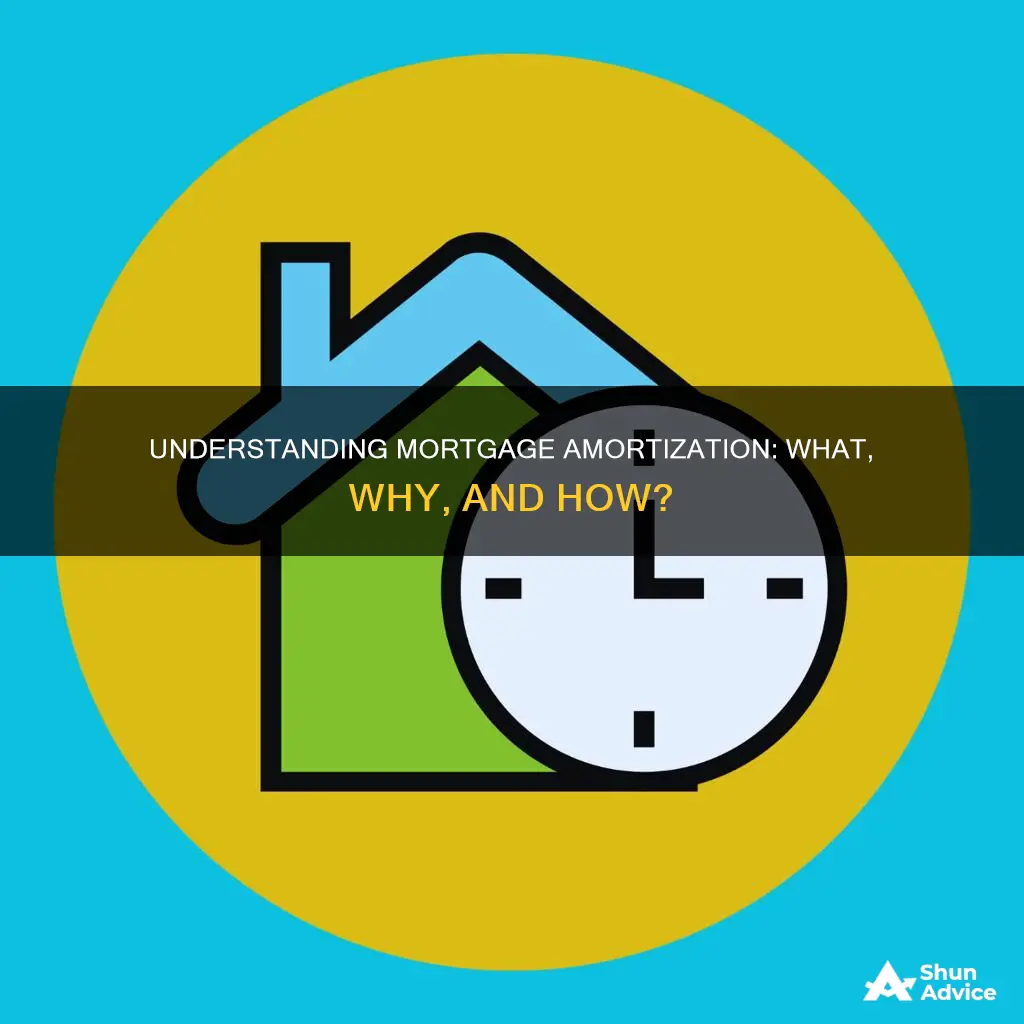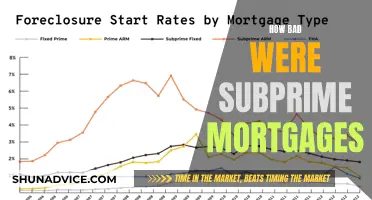
Amortization is the process of paying off a debt or loan over time in predetermined installments. With mortgage amortization, a portion of your monthly payment goes toward the principal (the amount you borrowed), and another portion goes to interest. The exact amount of principal and interest that make up each payment is shown in the mortgage amortization schedule. This schedule can be used to generate an amortization table, which will show you exactly how much principal and interest you're paying in each mortgage payment, as well as what your loan balance will be on any given date during your loan term.
| Characteristics | Values |
|---|---|
| Definition | Amortization is the process of paying off a debt or loan over time in predetermined installments. |
| Amortization period | The amortization period refers to how long it will take to pay off your mortgage in full. |
| Amortization schedule | A mortgage amortization schedule shows a breakdown of your monthly mortgage payment over time. It shows how much goes toward interest and principal in each payment, and what your principal balance is after each payment. |
| Amortization calculator | A mortgage amortization calculator can be used to generate an amortization schedule, which will show you exactly how much principal and interest you’re paying in each mortgage payment, as well as what your loan balance will be on any given date during your loan term. |
| Types of amortization | Fixed-rate mortgages are “fully amortizing,” which means that you’ll have paid the balance in full once you make all of your payments. Adjustable-rate mortgages (ARMs) may allow you to pay even less per month than a 30-year, fixed-rate mortgage, and you may be able to adjust payments in other ways that could match an expected increase in personal income. |
| Amortization and refinancing | When you refinance, you get a totally new loan, which restarts the amortization process. |
| Amortization and recasting | Mortgage recasting is a process that reamortizes your existing loan. With a recast, you pay a lump sum towards the principal, plus a fee. |
| Amortization and prepayments | You can pay additional money towards the principal at any time to accelerate the mortgage payoff process. Even a single extra payment made each year can reduce the amount of interest and shorten the amortization. |

Amortization schedules
The schedule is typically presented as a table, mapping out the entire repayment journey from the first payment to the final one when the loan matures. Each payment is itemized, showing the portion going towards interest and the part reducing the principal amount owed. This interest component is calculated based on the current outstanding balance, becoming smaller as the principal decreases over time.
The amortization schedule is particularly useful for borrowers with fixed-rate mortgages, as it provides a clear roadmap for their repayment journey. With each payment, borrowers can see their progress in chipping away at the principal and reducing their debt. This predictable structure allows for better financial planning and management of cash flow.
Additionally, the schedule can be used to compare different loan scenarios. For instance, borrowers can compare the total cost of a 30-year loan versus a shorter 15-year mortgage. This comparison helps borrowers make informed decisions, balancing the benefits of lower overall interest payments against potentially higher monthly instalments for shorter-term loans.
While amortization schedules are most commonly associated with mortgages, they are also used for other types of loans, such as auto loans and personal loans. However, it's important to note that they are generally not applicable to revolving credit facilities like credit cards, where the outstanding balance can be carried from month to month without a fixed repayment term.
Mortgage Application Assessments: What Lenders Look For
You may want to see also

Monthly payments
The monthly payments of a mortgage amortization are equal instalments paid over the life of the loan. This means that the total amount paid each month remains the same, but the portions of the payment going to interest and principal will vary. The first payment is largely dedicated to interest, with subsequent payments seeing a larger portion going to the principal balance. This is because the interest is calculated based on the principal balance, so as the principal decreases, so does the interest.
The monthly payments are determined by the interest rate, loan amount, and loan term. For example, a 30-year mortgage for $200,000 at a fixed interest rate of 5% will result in a monthly payment of $1,074, not including property taxes and insurance costs. Of that first payment, $833.33 will go towards interest, with $240.31 going towards the principal. This reduces the principal balance of the loan to $199,759. Over time, a larger portion of each payment will go towards the principal, with less going to interest.
The amortization schedule, or table, will show a breakdown of these monthly payments over time. It will detail how much will go towards the principal and interest at various times throughout the loan term. This schedule can be used to compare the total cost of loans with different terms, such as a 15-year loan versus a 30-year loan. It can also be used to calculate how much interest has been paid over the life of the mortgage, or during a particular year.
It is possible to pay off the mortgage more quickly by making extra payments towards the principal. This can be done by making larger or extra payments, or by making biweekly payments. However, it is important to ensure that the lender processes the payment in this way and to check for any penalties associated with making lump-sum prepayments. Additionally, it is important to consider one's financial situation and not forgo necessities to make extra payments.
Mortgage Broker Compensation: Fees, Commissions, and Salary Structures
You may want to see also

Loan principal
The loan principal is the amount borrowed from a lender. In the context of mortgage amortization, the loan principal is the amount borrowed to purchase a home. The loan principal is repaid in instalments over the life of the loan, along with interest.
Mortgage amortization is the process of paying off a mortgage loan through regular, equal payments that include both interest and principal. The loan principal is the amount you borrowed, and it is reduced after each payment as you chip away at the total amount. The interest you owe is based on the interest rate you locked in, and it covers the interest accrued during the previous month.
For example, consider a $300,000 30-year mortgage with a 6% interest rate. Your monthly payment would be $1,799 for the duration of the loan. However, your first payment would consist of $1,500 paid towards interest, and the remaining $299 paid towards the loan principal. Over time, you'll chip away at the principal, paying less towards interest and more towards the principal with each payment until the loan is paid off.
An amortization schedule can be used to track the breakdown of each payment, showing how much goes towards the loan principal and how much goes towards interest. This schedule can be generated using an online calculator. It is important to note that more interest is paid than the principal for about 60% of the life of the loan, and it is not until later in the loan term that more principal is paid than interest.
To pay off the mortgage more quickly, borrowers can make extra payments towards the loan principal. This can be done on a biweekly basis, with the monthly payment, or whenever extra funds are available. Shortening the amortization schedule can help borrowers pay less money over the life of the loan and accrue home equity faster. However, a shorter amortization schedule also means higher monthly payments.
Making Mortgage Overpayments: How Does It Work?
You may want to see also

Interest rates
Mortgages are typically repaid in equal installments over the life of the loan. Each installment consists of a payment towards the loan principal (the amount borrowed) and interest. In the early years of the loan, more interest is paid than the principal. This is because interest is calculated based on the outstanding balance of the loan, so as the balance decreases, the amount of interest paid also decreases over time.
For example, a $250,000 mortgage at a 3.5% interest rate would cost $154,000 in total interest over a 30-year fixed-rate loan, whereas a 15-year fixed-rate loan would cost $46,000 in total interest. A shorter amortization schedule means paying less money over the life of the loan and accruing home equity faster. However, a shorter-term loan also means higher monthly payments.
The interest rate on a fixed-rate mortgage remains the same for the life of the loan, providing stability for the borrower. On the other hand, variable-rate loans such as HELOCs (home equity lines of credit) can result in fluctuating monthly payments as interest rates change.
Mortgage Pre-Approvals: Are They Reliable?
You may want to see also

Refinancing
An amortization calculator can help you understand how much of your monthly mortgage payment goes toward interest and how much goes toward your principal balance. It can also show you how much you might save by refinancing with a lower interest rate or a shorter-loan term.
For example, a 30-year fixed-rate mortgage of $250,000 at a 3.5% interest rate would cost you $154,000 in total interest. However, if you were to refinance to a 15-year fixed-rate loan, you would only pay $46,000 in total interest.
It's important to note that a shorter amortization schedule may not be suitable for everyone, as the biggest drawback is that monthly payments will be much higher. Additionally, refinancing may not always be an option for borrowers with credit issues. In such cases, a loan recast or re-amortization may be a better option, as it allows borrowers to pay a lump sum toward their current mortgage balance and create a new payment schedule without taking out a new loan.
Understanding Mortgage Closing Costs: Who Pays What and When?
You may want to see also
Frequently asked questions
Amortization in real estate refers to the process of paying off your mortgage loan with regular monthly payments. These payments are made in equal installments over the life of the loan, though because the payment amount consists of principal and interest, it can vary.
The easiest way to calculate amortization is to use a mortgage amortization calculator that will create an amortization schedule for you. The schedule will show a breakdown of your monthly mortgage payment over time.
An amortization schedule is a table that lists each monthly payment from the time you start repaying the loan until the loan matures, or is paid off. The amortization schedule details how much will go toward each component of your mortgage payment — principal or interest — at various times throughout the loan term.
A shorter amortization period will result in higher monthly payments, but you will also save considerably on interest over the life of the loan, and you will own your home sooner. A longer amortization period will result in smaller monthly payments because you have more time to pay back the loan.
With a fixed-rate mortgage, your interest rate doesn't change, so your payments will remain relatively constant. With an adjustable-rate mortgage (ARM), your interest rate remains fixed for a certain number of years, usually 5 or 7, and then it might vary.







